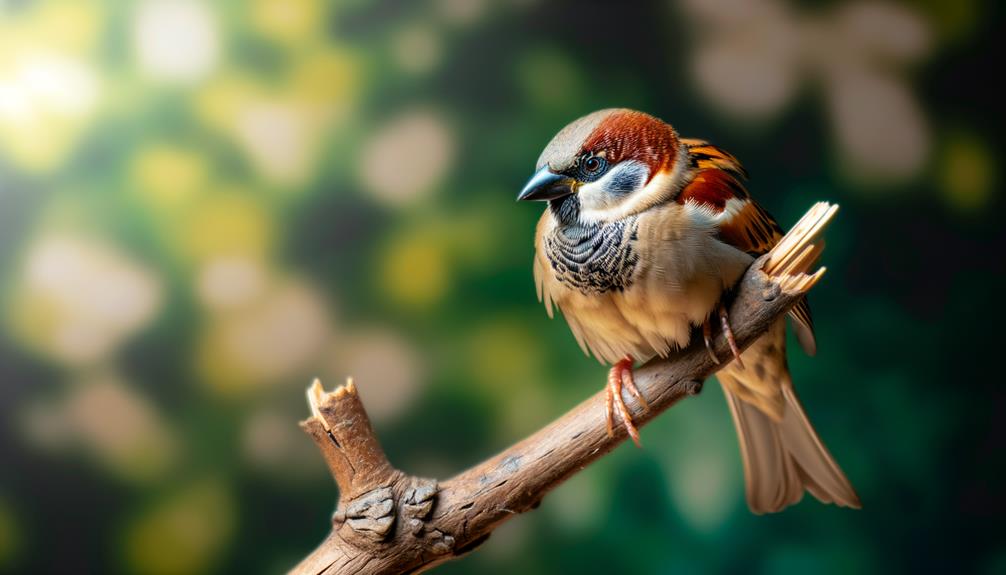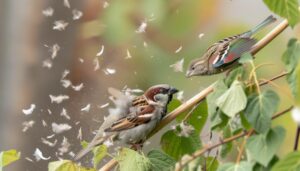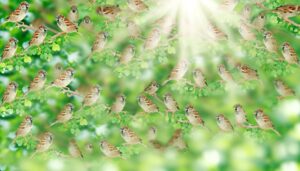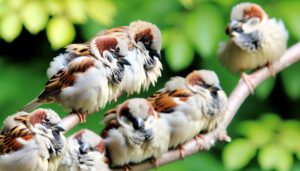How Much Does a House Sparrow Weigh?
House sparrows (Passer domesticus) typically weigh between 24 to 40 grams, with ecological and biological factors contributing to this range. Males generally weigh more, ranging from 24 to 30 grams, compared to females at 21 to 26 grams.
Juvenile sparrows have lower body mass than adults, gradually increasing with age until reaching peak physical condition. Seasonal variations, often linked to metabolic demands like breeding or winter preparation, also impact their weight.
Urban environments can result in higher body weights due to increased food availability. For further insights into the factors influencing these weight variations and their implications, continue exploring.

Key Takeaways
- House sparrows weigh between 24 to 40 grams.
- Male sparrows typically weigh 24 to 30 grams.
- Female sparrows generally weigh 21 to 26 grams.
- Juvenile sparrows weigh less than adults, with hatchlings at 1.5 grams.
- Seasonal weight fluctuations occur, with sparrows gaining weight for winter.
Average Weight
The average weight of the house sparrow (Passer domesticus) ranges from 24 to 40 grams, depending on factors such as age, sex, and geographical location. This variability is influenced by ecological and biological determinants.
Studies indicate that sparrows residing in colder climates tend to weigh more, attributed to increased fat reserves essential for thermoregulation. Juvenile sparrows typically weigh less than adults, reflecting their developmental stage. Additionally, seasonal changes impact weight, as sparrows accumulate fat in preparation for winter or during breeding periods.
Accurate weight measurements are critical for avian research, offering insights into health, behavior, and environmental adaptation. Consistent data collection allows ornithologists to monitor population dynamics and assess ecological impacts on this widespread species.
Male Vs Female
Sexual dimorphism in house sparrows manifests in distinct weight differences between males and females. Empirical studies indicate that male house sparrows (Passer domesticus) typically exhibit greater body mass compared to their female counterparts. Adult males generally weigh between 24 to 30 grams, whereas females usually fall within the 21 to 26-gram range.
This weight disparity is primarily attributed to sexual selection and ecological factors. Males often require increased muscle mass for territorial defense and mating displays, which contributes to their higher body weight. Conversely, females, investing more energy in reproductive processes such as egg production, maintain a lower body mass.
Understanding these weight differences is vital for avian biologists studying species-specific adaptations and ecological dynamics.
Weight by Age
Beyond the differences in weight between male and female house sparrows, age also plays a significant role in determining body mass. Juvenile sparrows typically weigh less than their adult counterparts due to ongoing growth and development. As sparrows mature, their weight stabilizes, reflecting their peak physical condition. Scientific observations have documented the following average weights across various age categories:
| Age Group | Average Weight (g) | Weight Range (g) |
|---|---|---|
| Hatchlings | 1.5 | 1.3 – 1.7 |
| 1 Week Old | 4.0 | 3.5 – 4.5 |
| 2 Weeks Old | 8.0 | 7.0 – 9.0 |
| Juvenile | 20.0 | 18.0 – 22.0 |
| Adult | 30.0 | 28.0 – 32.0 |
These variations underscore the importance of age-specific factors in avian weight studies and their implications for ecological and physiological research.
Seasonal Variations
Seasonal variations greatly influence the weight of house sparrows. Notable increases during winter months are observed due to greater fat reserves needed for thermoregulation. Additionally, the breeding season introduces weight fluctuations associated with energy expenditure and resource allocation for reproductive activities.
Food availability, which varies seasonally, further impacts body mass. This underscores the intricate relationship between environmental factors and physiological adaptations in house sparrows.
Weight Changes in Winter
During winter, house sparrows (Passer domesticus) typically exhibit significant weight fluctuations as a physiological response to colder temperatures and reduced food availability.
The basal metabolic rate (BMR) of these birds increases to generate additional body heat, necessitating higher energy consumption. Consequently, sparrows often increase their body fat reserves in anticipation of scarce food supplies, leading to weight gain during the early winter months.
However, prolonged periods of limited food access result in subsequent weight loss. Studies indicate that wintering house sparrows can experience a weight variation of up to 15% from their baseline body mass.
This cyclical weight change is essential for their survival, enabling them to endure the energetically demanding winter conditions.
Breeding Season Impact
Contrasting the winter weight fluctuations, the breeding season introduces a different set of physiological demands on house sparrows, impacting their body mass and overall condition. During this period, metabolic rates increase as energy is diverted towards activities such as nest building, egg production, and feeding offspring. Consequently, variations in weight can be observed, often influenced by the reproductive roles of males and females.
| Season | Male Weight (g) | Female Weight (g) |
|---|---|---|
| Winter | 28 – 34 | 26 – 32 |
| Breeding | 30 – 36 | 28 – 34 |
| Post-Breeding | 27 – 33 | 25 – 31 |
| Molting | 29 – 35 | 27 – 33 |
These weight fluctuations underscore the adaptive strategies employed by house sparrows to meet the demands of their reproductive cycle.
Food Availability Effect
Fluctuations in food availability, dictated by seasonal changes, profoundly influence the weight and overall health of house sparrows. During winter, reduced access to high-energy food sources such as seeds and insects leads to a significant decline in body mass. Studies indicate that sparrows can lose up to 15% of their body weight during these months.
Conversely, spring and summer bring an abundance of food, promoting weight gain and best health. The availability of protein-rich insects during breeding season is particularly essential, supporting both adult sparrows and their developing offspring.
Research consistently shows a positive correlation between food supply and body condition, underscoring the importance of seasonal food availability in maintaining the physiological well-being of house sparrows.
Dietary Impact
The dietary intake of house sparrows (Passer domesticus) greatly influences their body weight. Variations in nutrient composition and availability play important roles in their overall health and fitness.
Studies indicate that a diet rich in high-energy seeds, insects, and grains supports best weight maintenance. Nutrient-deficient diets can lead to significant weight loss and compromised immune function. Protein and fat content are particularly vital; sparrows consuming diets high in these macronutrients exhibit higher body mass indices.
Seasonal changes in food availability can alter dietary composition, subsequently affecting weight. For instance, insect abundance in warmer months promotes higher protein intake, essential for breeding and molting periods.
Therefore, dietary quality directly impacts the physiological condition and survival prospects of house sparrows.
Regional Differences
Given the notable influence of diet on house sparrow weight, it is imperative to examine how regional differences in food availability and environmental conditions further impact their body mass and overall health.
In colder climates, house sparrows often exhibit higher body weights due to increased fat reserves required for thermoregulation. Conversely, in warmer regions, sparrows may have lower body mass due to reduced metabolic demands.
Studies indicate that variations in local flora and fauna markedly affect the nutritional intake of sparrows, with areas rich in insects and seeds contributing to better overall health and higher body weights.
Additionally, regional differences in predation pressures and human activity can further influence feeding behaviors and energy expenditure, thereby affecting their weight profiles.
Urban Vs Rural Sparrows
Sparrows inhabiting urban environments often exhibit distinct differences in weight and health compared to their rural counterparts, primarily due to variations in food availability, pollution levels, and human interactions. Urban sparrows typically have access to abundant food sources, such as discarded human food, leading to higher average body weights. However, increased exposure to pollutants and reduced natural food can negatively impact their overall health.
Conversely, rural sparrows, though less exposed to pollutants, may experience more limited food availability, influencing their leaner body mass. Studies have demonstrated that urban sparrows often face higher rates of obesity and related health issues. Additionally, human interactions in urban settings can alter feeding behaviors, further contributing to the observed weight differences between urban and rural sparrow populations.
Nestling and Fledgling Weights
Nestling and fledgling weights in House Sparrows exhibit substantial variation driven by growth rate dynamics and environmental factors. Empirical studies indicate that nutritional availability and parental investment greatly influence the mass and development trajectory of young sparrows.
Additionally, intra-brood competition and habitat conditions contribute to the observed weight variability during these critical early stages of life.
Growth Rate Dynamics
The growth rate dynamics of house sparrow nestlings and fledglings are critical indicators of their overall health and developmental progress, often measured through systematic weight tracking from hatching to fledging. Initial post-hatching weights typically range from 1.5 to 2 grams. Rapid growth ensues, with nestlings often doubling their weight within the first week.
Weight Variability Factors
Several biotic and abiotic factors contribute to the variability in house sparrow nestling and fledgling weights, encompassing genetic predispositions, parental provisioning rates, environmental conditions, and interspecific competition. Genetic factors determine baseline metabolic rates and growth potentials. Parental provisioning rates, influenced by food availability, directly affect weight gain. Environmental conditions, such as temperature and habitat quality, also play significant roles. Interspecific competition can limit resources, impacting weight.
| Factor | Influence on Weight | Example |
|---|---|---|
| Genetic Predispositions | Baseline metabolic rates | Heritable growth traits |
| Parental Provisioning | Nutrient intake | Frequency of feeding |
| Environmental Conditions | Habitat quality | Temperature fluctuations |
| Interspecific Competition | Resource availability | Presence of competing species |
Understanding these factors provides insight into the complex dynamics affecting house sparrow weights.
Health and Weight
A thorough understanding of the health and weight of house sparrows (Passer domesticus) is important for evaluating their overall fitness and survival rates. Health metrics, such as body condition and fat reserves, directly correlate with weight. These factors are critical for evaluating the birds' ability to withstand environmental stresses and reproductive success.
Scientific research indicates that an average house sparrow weighs between 24 to 40 grams. Variations in weight can be attributed to multiple health-related factors, including:
- Nutritional intake: Adequate food availability ensures prime body mass.
- Parasite load: Infestations can notably reduce body weight.
- Disease prevalence: Illnesses can lead to weight loss.
- Seasonal changes: Weight fluctuates with seasonal food availability and breeding cycles.
Understanding these variables provides insights into the ecological health of house sparrow populations.
Measuring Techniques
Accurately measuring the weight of house sparrows requires the use of precise tools and standardized procedures to guarantee reliable data collection. Digital gram scales, calibrated to the nearest tenth of a gram, are preferred for their accuracy.
Birds should be gently but securely placed in a mesh or cloth bag to minimize movement and stress. The bag's tare weight must be subtracted from the total to obtain the bird's net weight.
Consistent time of day for measurements can control for diurnal weight fluctuations. Additionally, ensuring environmental conditions, such as temperature and humidity, are stable can mitigate external influences.
Utilizing these rigorous techniques provides reproducible and accurate weight data essential for ornithological studies and ecological monitoring.
Weight and Flight
The relationship between a house sparrow's weight and its flight performance is crucial, influencing factors such as maneuverability, energy expenditure, and overall fitness. Research indicates that ideal weight is necessary for efficient flight mechanics.
- Maneuverability: Heavier sparrows may experience reduced agility, affecting their ability to evade predators.
- Energy Expenditure: Increased body mass requires greater energy output, impacting endurance during prolonged flights.
- Wing Loading: A higher weight increases wing loading, changing the aerodynamic efficiency and flight speed.
- Fitness: Weight fluctuations can impact reproductive success and survival rates, with underweight or overweight individuals facing higher risks.
Understanding these dynamics is essential for comprehending how slight variations in weight can significantly influence a house sparrow's ecological and biological functions.
Comparing to Other Birds
House sparrows exhibit unique weight characteristics when compared to other avian species, highlighting distinct differences in flight mechanics and energy management strategies. Typically weighing between 24 to 40 grams, house sparrows are lighter than many passerine birds, such as robins (Turdus migratorius), which average around 77 grams. This reduced mass requires less energy for takeoff and sustained flight.
Conversely, heavier birds like the European starling (Sturnus vulgaris), which can weigh up to 100 grams, have adapted with stronger musculature and different flight patterns to manage their greater weight. These variances in avian weight influence their respective metabolic rates, foraging behaviors, and ecological niches, illustrating the intricate balance between anatomy and environmental adaptation in bird species.
Conclusion
To sum up, the weight of a house sparrow is influenced by multiple factors, including gender, age, and seasonal changes. Males generally weigh more than females, and both sexes exhibit weight fluctuations due to dietary intake and health conditions.
Seasonal variations further affect their mass, akin to how a tree's foliage changes with the seasons. Accurate measurement techniques are essential to understanding these dynamics, which can be compared across different bird species to provide a thorough ecological perspective.






